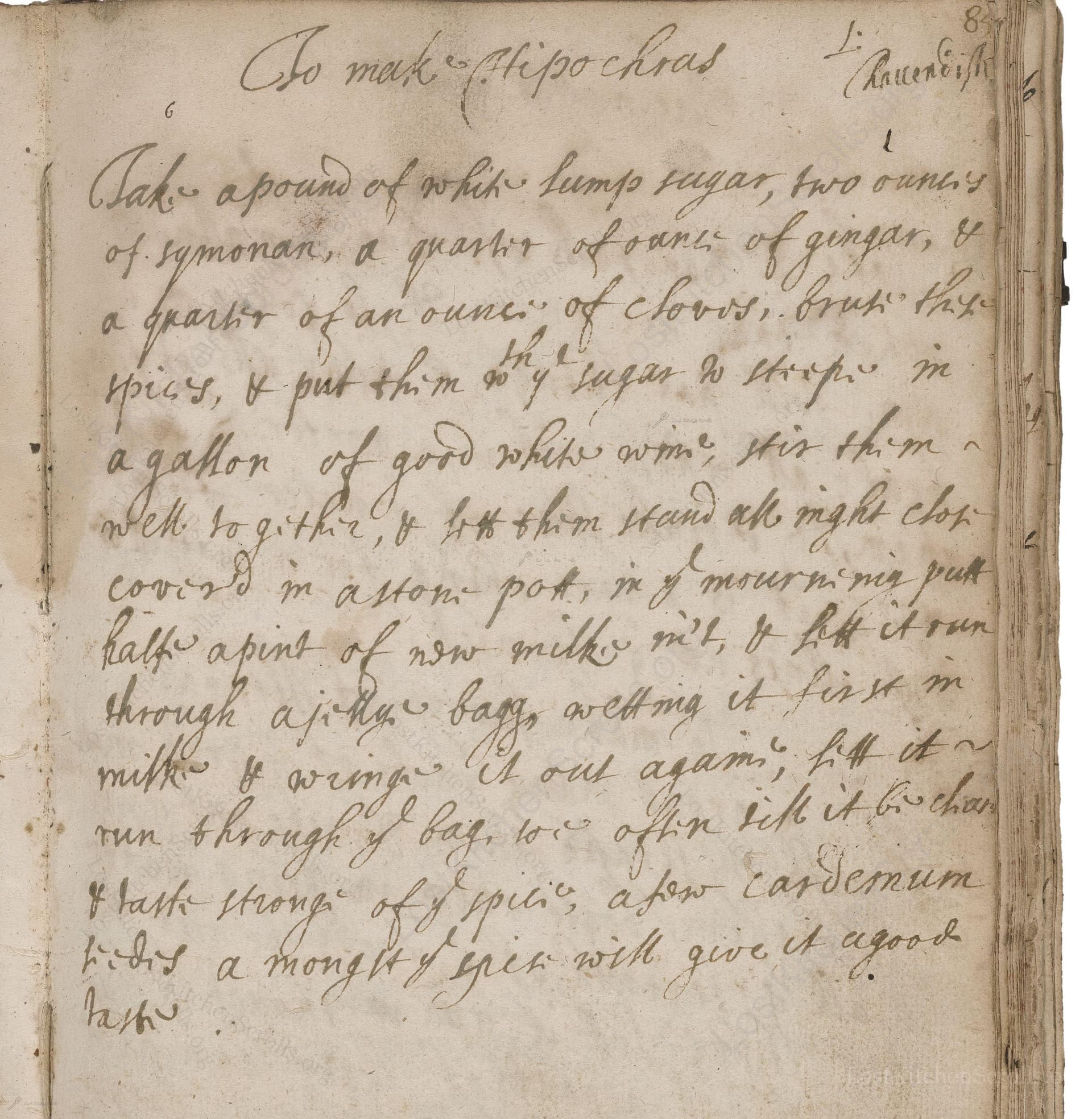To Make Hippochras
From the treasured pages of The Lady Grace Castleton's booke of receipts
Written by Grace Saunderson, Viscountess Castleton

To Make Hippochras
"Take a pound of white lump sugar, two ounces of symonan, a quarter of ounce of gingar, & a quarter of an ounce of cloves. bruse these spices, & put them wth ye sugar to steepe in a gallon of good white wine, stir them well togither, & lett them stand all night close cover'd in a stone pot, in ye mourning putt half a pint of new milke in't, & lett it run through a jelly bagg, wetting it first in milke & wringe it out againe, lett it run through ye bagg, soe often till it be clear & taste stronge of ye spice, a few cardemum seeds a thought of spice will give it a good taste."
Note on the Original Text
Early modern English recipes often favor brevity and assume a basic household knowledge, giving general instructions rather than precise steps. Spellings like 'symonan' (cinnamon), 'gingar' (ginger), and 'ye' (the), as well as formulations such as 'lett it run through ye bagg soe often till it be clear', suggest both the evolving English language and the open-ended approach to technique. Recipes like this serve as both guides and reminders, helping experienced cooks and stewards recapture flavors they knew, rather than offering complete measurements for novices. The inclusion of sugar, imported spices, and the clarification with milk marks this as a high-status recipe, demonstrating taste and wealth.

Title
The Lady Grace Castleton's booke of receipts (1650)
You can also click the book image above to peruse the original tome
Writer
Grace Saunderson, Viscountess Castleton
Era
1650
Publisher
Unknown
Background
A delightful voyage into 17th-century English kitchens, this collection reveals the refined tastes and culinary secrets of the aristocracy, serving up a sumptuous array of period recipes and gracious domestic wisdom.
Kindly made available by
Folger Shakespeare Library
This recipe comes from the 17th century household manuscript of Grace Saunderson, Viscountess Castleton, who died in 1667. Hippochras was a popular spiced wine drink in England and across Europe, often served at festive tables and banquets as both a health tonic and a luxurious after-dinner treat. The addition of milk to clarify the wine was a common practice in early modern Britain, resulting in a clear and richly flavored beverage that was regarded as both medicinal and indulgent. Such recipes circulated amongst the nobility and gentlefolk, showing both the reach of international spices and changing tastes for refined, clarified drinks. Hippochras bridges the late medieval and early modern approach to spiced alcoholic beverages.

Back in the 1600s, you would have used a large stoneware or earthenware pot as your steeping vessel. Spices were crushed using a mortar and pestle. Straining was done with a jelly bag—a simple cloth filter, often set in a hoop, or several layers of clean fine linen. The steeping and clarification process relied on patience and gravity, with repeated strainings to gently coax the Hippochras to clarity and brilliance.
Prep Time
15 mins
Cook Time
0 mins
Servings
16
We've done our best to adapt this historical recipe for modern kitchens, but some details may still need refinement. We warmly welcome feedback from fellow cooks and culinary historians — your insights support the entire community!
Ingredients
- 1 lb white granulated sugar
- 2 oz cinnamon sticks (or cassia bark)
- 1/4 oz fresh ginger (peeled and sliced, or ground)
- 1/4 oz whole cloves
- 1 gal dry white wine (e.g., Sauvignon Blanc)
- 1 1/4 cups fresh whole milk
- 5 pods green cardamom (optional, lightly crushed)
- A pinch of mixed spice or allspice (optional, for taste)
Instructions
- To make Hippochras today, begin by gently crushing your spices: cinnamon, ginger, cloves, and cardamom.
- Combine 1 pound of white granulated sugar with 2 ounces of cinnamon sticks, 1/4 ounce of fresh ginger, and 1/4 ounce of whole cloves.
- Stir these into 1 gallon of a good quality dry white wine (such as Sauvignon Blanc) in a large non-reactive container, preferably a ceramic or glass vessle.
- Cover and let steep overnight to infuse the flavors fully.
- The next morning, add 1 1/4 cups of fresh whole milk.
- Stir gentely, then strain the entire mixture through a jelly bag or several layers of cheesecloth pre-rinsed in milk (to prevent initial absorption).
- Repeat the straining as needed until the beverage runs clear and fragrant.
- For a dash of extra flavor, add a sprinkle (about 5 crushed pods) of green cardamom and a pinch of mixed spice if you desire.
- Serve chilled or slightly cool.
Estimated Calories
210 per serving
Cooking Estimates
You will spend about 15 minutes preparing the ingredients and mixing everything together. Most of the time is just waiting for the spices to infuse overnight. Each serving has about 210 calories, and this recipe makes about 16 servings.
As noted above, we have made our best effort to translate and adapt this historical recipe for modern kitchens, taking into account ingredients nowadays, cooking techniques, measurements, and so on. However, historical recipes often contain assumptions that require interpretation.
We'd love for anyone to help improve these adaptations. Community contributions are highly welcome. If you have suggestions, corrections, or cooking tips based on your experience with this recipe, please share them below.
Join the Discussion
Rate This Recipe
Dietary Preference
Culinary Technique

Den Bockfisch In Einer Fleisch Suppen Zu Kochen
This recipe hails from a German manuscript cookbook compiled in 1696, a time whe...

Die Grieß Nudlen Zumachen
This recipe comes from a rather mysterious manuscript cookbook, penned anonymous...

Ein Boudain
This recipe comes from an anonymous German-language manuscript cookbook from 169...

Ein Gesaltzen Citroni
This recipe, dating from 1696, comes from an extensive anonymous German cookbook...
Browse our complete collection of time-honored recipes



